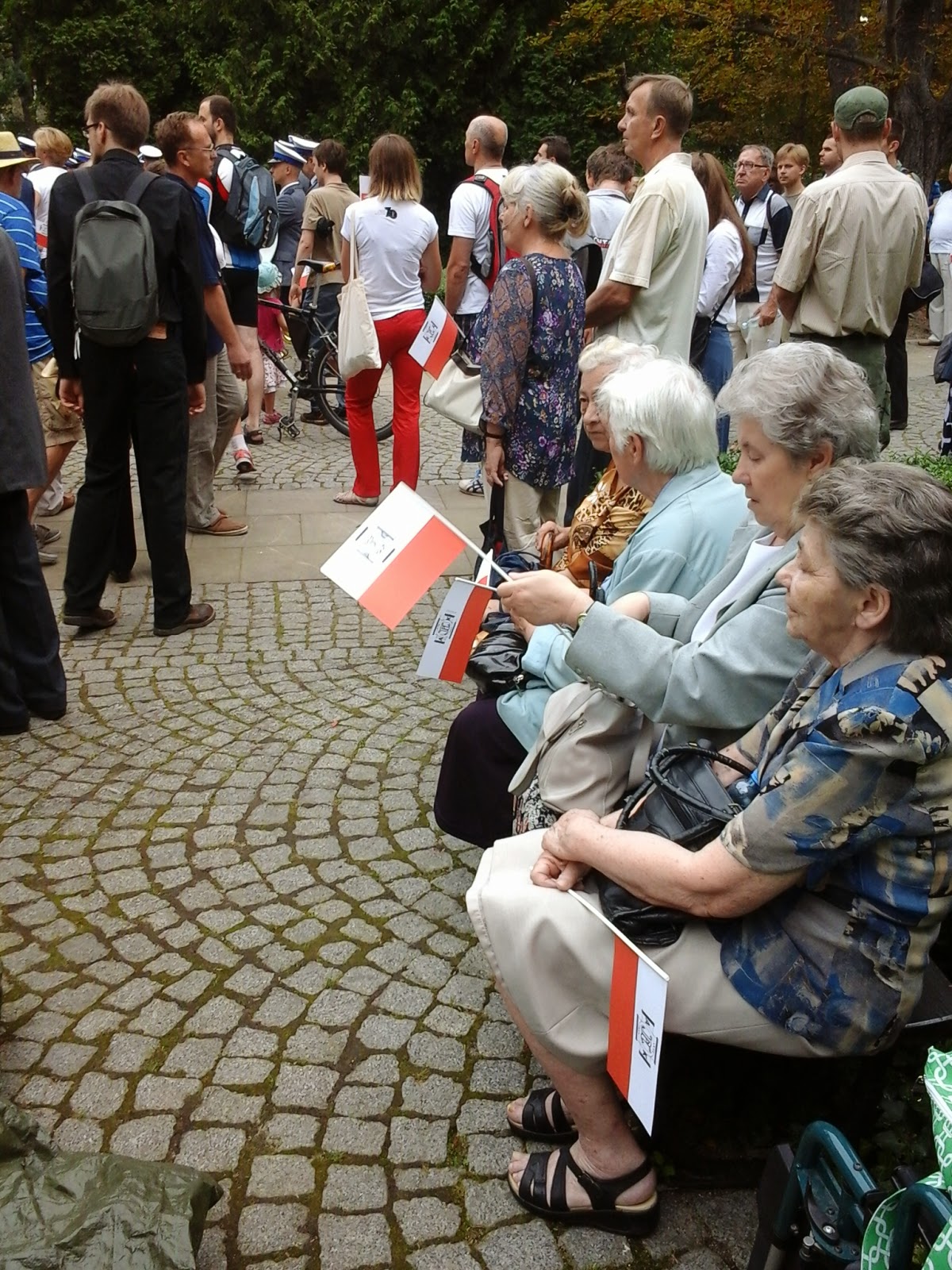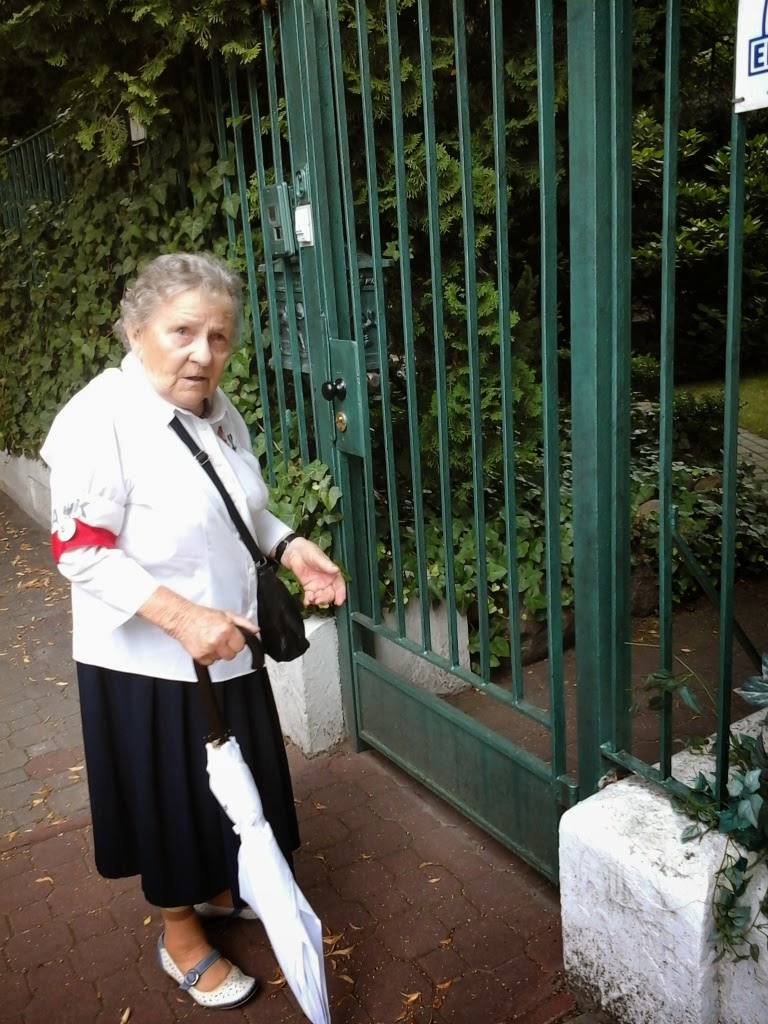Every 1st August at 5:00 p.m., Warsaw freezes for a minute to commemorate the outbreak of the most fascinating insurrection of the WWII. It looks like this:
https://www.youtube.com/watch?v=zv4FnkGyAbQ
The Home Army, the clandestine army created by Polish officers after the fall of Warsaw in 1939, organising the resistance in occupied Poland, gave the order to start an open fight. Warsaw had been subjected to horrendous terror by the Germans where the inhabitants were fished from streets blocked at both ends and then taken to camps, where whole families or houses were executed for hiding one Jew, where for one killed German ten Poles were hanged in the streets.......
The order to start the rising was accelerated by the announcement that the Germans called 100 000 Poles for digging the trenches as they had declared Warsaw Festung Warschau. Failure to arrive for the call would be punished. And that meant only one punishment: death.
The start of the Rising was marked as "W" Hour.
======================
The commemorating
events are always organised by Museum of Warsaw Uprising, created by late
President Lech Kaczynski.
The Insurgents along
with their assisting members of family, should the case be, were invited by the
Museum and the city of Warsaw to come and stay at the expense of the organisers.
I came with my Mother, 90, who has a bad sight and unstable walk. We were
lodged in Radisson blu Grzybowska, and at the reception were presented with a
welcome letter by the owner who felt honoured to be able to host heroes.
The celebrations
were planned for 3 days.
On the arrival
every former soldier was asked to collect the “event package” containing the
programme and umbrella. On the first day in the morning there was a meeting
with the presidents of the country and the city in the Yard of Freedom of the Warsaw
Uprising Museum. There were special buses taking the guests from each hotel to
the venue. The day was hot so the umbrellas were just the right thing. Many
volunteers were milling around distributing mineral water. During the ceremony,
the president awarded many persons with various medals. It was also announced
that the historic sign of the resistance presenting the letter “P” based on an
anchor, that used to be painted on the walls of the occupied city, had been
protected by a special order by the president.
 |
| The outpost of the Museum; the portrait of young prof. Kiezun |
 |
| The Insurgents and invited guests are arriving at the museum on foot ... |
 |
| .... or by electric cars from the bus station |
 |
| Arrival of the scouts |
 |
The Remembrance Wall and the "Monter" Bell named after the Commander.
Me with my Mum |
 |
| The umbrellas helped in the sun |
 |
| Representatives of the USArmy |
 |
| Volunteers offering mineral water |
 |
| After the event, there were chairs provided for the elderly while waiting for the hotel buses |
 |
| A volunteer informing about the right hotel bus |
In the
afternoon, at the Warsaw Town Hall there was another meeting to which the
Insurgents were brought by special buses followed by a concert of songs written
specifically for the occassion.
.JPG) |
| President of the city of Warsaw |
.jpg) |
| The Town Hall with the stage setting |
.jpg) |
| The show |
 |
| Old friends have met |
 |
The Insurgents
|
 |
| Guests from London |
 |
| Prof. Norman Davies sitting behind my Mother |
In the evening a
new film “City 1944” by a young director was shown on the National Stadium. It
was the first night performance; the regular shows in cinemas across the
country start in September.
 |
| The Stadium |
 |
| Waiting for the film |
 |
| Introduction by a piece of trumpet music |
The next day saw
the holy mass at the monument of the Insurgents in the Krasińskich Square at
6:00 p.m. The monument is located opposite the Military Cathedral.
 |
| The Cathedral in the setting sun |
 |
| The Field Bishop arrives with assisting priests |
 |
| The Military Representative Band is ready |
 |
| The representative company firing honorary salute |
After the mass
there were some speeches and wreaths laying. 60 of them. This was followed by a
concert “The Song of the Walls” where original texts of letters carried by
small boy scouts from one part of Warsaw to another were cited, accompanied by
music.
 |
| The show was very moving and well performed |
On the most important
day, 1st August, celebrations in many parts of Warsaw started in the
morning.
.JPG) |
| We started at the Orlicz-Dreszera Park in Warsaw-Mokotów at 10:00 a.m. |
.JPG) |
| Wreath laying at the monument |
.JPG) |
| the horse guard |
.JPG) |
| A volunteer collecting money for the renovation of insurgents' graves |
.jpg) |
| The public |
.jpg) |
| The public |
.jpg) |
Historic soldiers
|
 |
| From the park, my Mum took me to her sanitary post where she was looking after wounded insurgents |
 |
| Behind this gate, on the left 5 insurgents were buried killed by Germans as they lay in their beds in the house |
 |
| Here was an entrance into the cellars |
 |
Opposite the nurses' post, at number 15, a unit of Jews were stationing who were collecting the dead
|
At noon there was an oak tree planting and the Change of Guards in the Piłsudskiego Square.
 |
| The plate informing about the purpose of the oak tree |
 |
| The Oak |
My Mother was approached by a radio reporter and was asked to give an interview.
 |
| All around soldiers, scouts, Polish flags |
The old heroes were being transported by the buses to most of the sites and in the afternoon to the key event – the “W” Hour at the military cemetery with thousands of graves and the Gloria Victis monument where the central ceremony is held every year.
.jpg) |
We first went to the grave of my Grandfather, chief of one of the Sections in the General Commander's Office, responsible for the Home Army money. He was shot dead by a sniper on the third day of the Rising
|
.jpg) |
| Scout and academic corporation organisations marching towards the Gloria Victis monument |
.jpg) |
| The grave of the Commander "Monter" |
.jpg) |
The monument devoted to all Soldiers of Fighting Poland
|
 |
| Gloria Victis |
From that cemetery the buses took us to another cemetery which holds the bodies of at least 50 000 civilians murdered by the Germans over the first few days of the Uprising in the Wola city district.
.jpg) |
| Behind the soldiers a monument over the graves of the civilians |
.jpg) |
| A prayer by 4 religious ministers: Catholic bishop, Lutheran bishop, Orthodox minister and Poland's Chief Rabbi |
In the evening, in
the Piłsudskiego Square, as usual there was a very touching gathering of many
people coming to sing the old songs of the time of occupation and rising. The
event gathers hundreds of thousands of people because the atmosphere is unique
and everybody feels proud to be a Pole.
Unfortunately, this year I did not manage to return on time from the cemetery.
The Insurgents were presented with an album with their portraits taken the previous year. There are 850 of them. Along one of the major streets in Warsaw, the album was put up on special stands.
 |
| The portraits along the street close to the Parliament |
 |
| me & Mum |
 |
| Me and one of the most famous Insurgents, who is portrayed on a post stamp issued on the occasion |
Some 400 m further, on a fence of the Łazienki Park I found several posters presenting pre-war officers who took part in the Uprising, and found my Grandfather :) with the history of his military life.
My late Father also took part in the Uprising although very soon his formation ceased existing due to heavy fights.
Yet, it is marked on his grave that he used to be an AK soldier (Armia Krajowa - Home Army).
Although the Uprising was a military defeat, it was not in vain. As prof. Norman Davies put it 10 years ago when launching his book Rising '44 in the Gdańsk Shipyard, reputed for the Solidarity movement: "Solidarność would not be so obviously possible if not the Warsaw Rising of 1944".










.JPG)
.jpg)
.jpg)











.JPG)
.JPG)
.JPG)
.JPG)
.jpg)
.jpg)
.jpg)







.jpg)
.jpg)
.jpg)

.jpg)
.jpg)







.jpg)


Brak komentarzy:
Prześlij komentarz